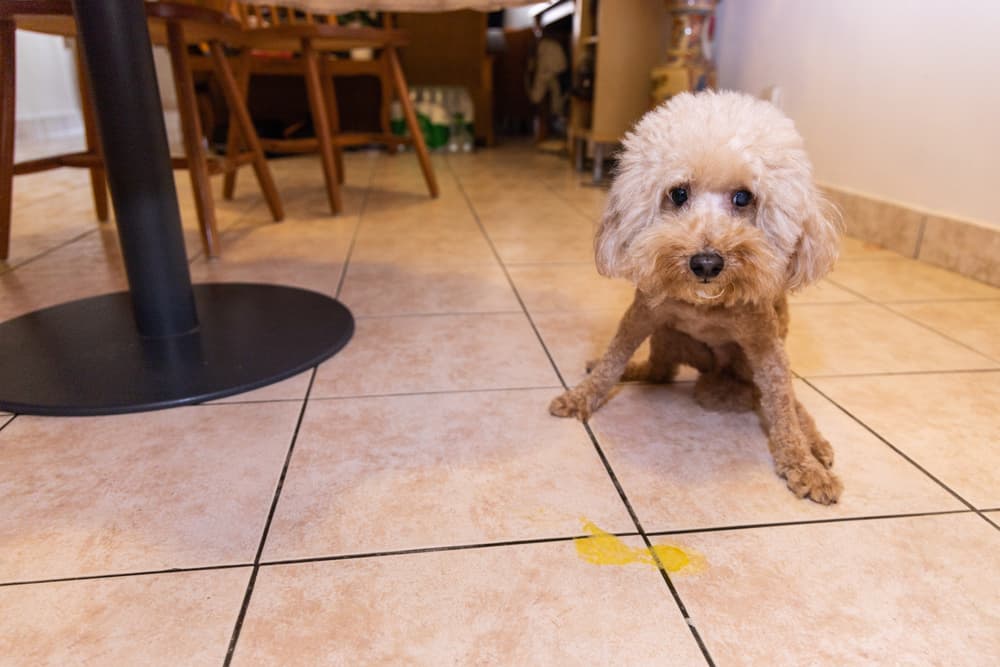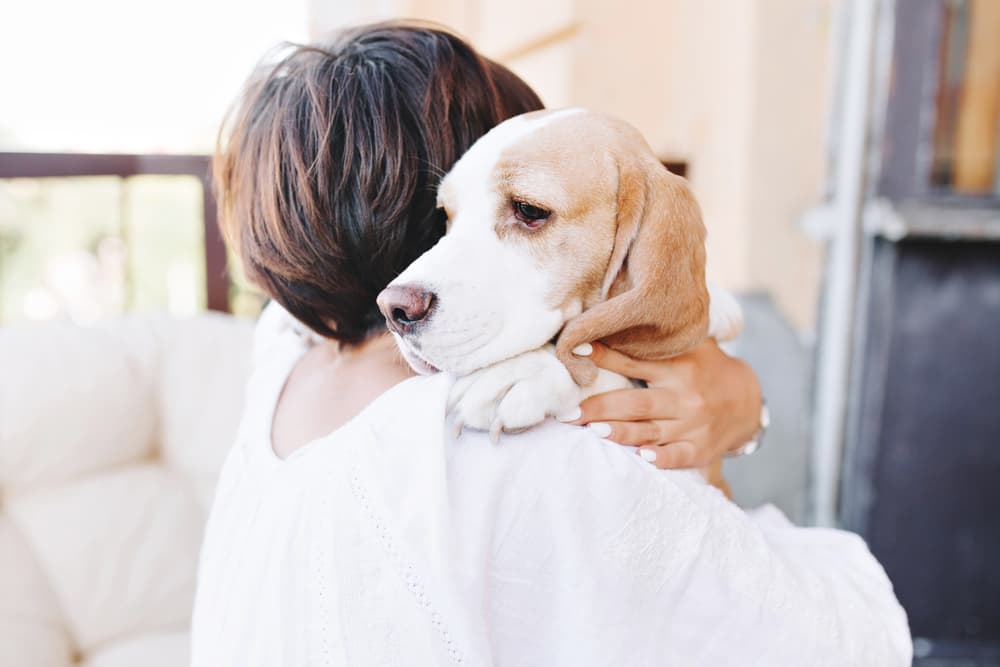Dog Vomiting Yellow: Causes and Treatment

As humans, we don’t usually run to the doctor for a single episode of vomiting. We can usually tell when we have a little bug or if something more serious is brewing within us. But since our pets can’t talk, it’s harder to know what to do when they vomit or how concerned you should be.
Dogs can vomit almost every color in the rainbow. Yellow dog vomit is one of the most common. While it could be benign, sometimes a dog vomiting yellow can be a sign of something serious.
Is your dog vomiting yellow? Read on to learn reasons why, what it could mean, how to treat and prevent it, and when to seek veterinary attention.
Dog Vomiting Yellow: Is It a Cause for Concern?

Like people, dogs will can have an upset stomach that causes vomiting. It can be alarming when it happens, but it’s important to observe your pet for other signs of illness or repeated episodes of throwing up. You should also take note of the color and contents of the vomit.
Yellow vomit usually indicates stomach bile. The yellow coloration is usually very evident if your dog’s stomach was empty when they vomited. If you notice any blood or red-tinge to the vomit, contact your veterinarian. This could indicate bleeding in the GI tract, which can be painful and worsen over time.
If your dog only vomited yellow once, it’s okay to wait. Observe them for 24 hours and note any other unusual behaviors. Also, keep an eye out for more vomiting or any other signs of illness like diarrhea, lethargy, loss of appetite, weakness, or collapse. If you see any of these other symptoms, take your dog to a veterinarian as soon as you can. Don’t wait more than 48 hours to seek veterinary care in these instances. The longer you wait, the worse a condition can become, and the harder (and more expensive) it can be to treat.
Types of Yellow Dog Vomit

Yellow dog vomit doesn’t always look the same. It may appear as:
- Yellow foam
- Yellow mucus
- Watery yellow liquid
Usually, when a dog vomits bile, it will be a small amount of vomit with a yellow foamy appearance. Bile in vomit can also appear like a slimy yellow mucus.
Sometimes yellow dog vomit can be watery. Watery vomit usually happens if your dog drank a lot of water before throwing up. This can still indicate bile, but watery yellow vomit is less common.
Usually, when a dog vomits bile, it’s linked to an empty stomach. That means there will often be little to no kibble or food in your dog’s throw up.
Sometimes, a dog’s throw up is yellow for reasons unrelated to bile. Usually, in these cases it will be more watery and may contain grass or another foreign object.
Why is My Dog Vomiting Yellow?

When dogs vomit yellow, it is usually caused by bile. Bile is a natural substance produced by a dog’s liver that assists with the digestive process. It’s stored in the gallbladder and released into the very first part of the small intestine, just past the stomach.
While bile is the most common cause of yellow vomit in dogs, there are other reasons you may see this symptom. Here are the most common causes:
Bilious Vomiting Syndrome
Some dogs have a condition in which whenever their stomach is empty, the bile can back up into the stomach. This irritates the digestive system and causes the dog to vomit. Dogs with bilious vomiting syndrome often vomit early in the morning or late at night. It usually occurs in younger dogs. These dogs often do not lose their appetite and otherwise behave normally.
This syndrome is a diagnosis of exclusion. That means your dog should see a veterinarian to make sure their vomiting is not a sign of something more serious.
Liver and/or Gallbladder Disease
A disorder or disease of the liver, which produces bile, or the gallbladder, which stores bile, or both, can cause a dog to have repeated episodes of yellow vomit. Dogs with liver disease often do not feel well in general. In this cases, you may see other signs of illness like lethargy, loss of appetite, jaundice, or weight loss.
Eating Something They Shouldn’t
When dogs eat things they’re not supposed to—like human food, trash, or something in the backyard— it can lead to gastritis. This irritation can lead them to vomit until their stomach is empty, which enables bile to come up.
Food Allergies or Dietary Intolerances
Consuming a food, ingredient, or substance your dog is allergic to can cause them to vomit, which may include and yellow bile. This is usually noticed after switching to a new dog food, or switching foods too fast. However, allergies and dietary intolerances can develop at any point in a pet’s life. Dogs who are vomiting because of a food allergy or dietary intolerance will usually vomit soon after eating. Also, food or kibble will likely be present in the vomit.
They Ate Something Yellow
Your dog vomiting yellow doesn’t always mean bile. Sometimes, they ate yellow grass, yellow foods, or even a yellow toy. In these situations, you will often see the originally yellow ingested object—but not always. That’s especially true if the object is too big or heavy to make its way back up the esophagus.
Intestinal Blockage
Occasionally, dogs eat something they can’t digest properly, like socks, toys, or large bones. These items are too large to move through your dog’s intestinal tract and become lodged somewhere past the stomach and before the colon. This will cause intestinal secretions, like bile, to back up into the stomach and lead to vomiting. An intestinal obstruction in dogs is a very serious medical emergency. These pets cannot keep anything down, and will even vomit water.
Other Diseases
Yellow dog vomit can be a sign or symptom of many major systemic diseases. Some of these conditions include pancreatitis (inflammation of the pancreas), infectious diseases, kidney disease, internal parasites, inflammatory disorders, toxin exposure, cancer, and more. These cases are also often associated with lethargy, weight loss, and diarrhea.
Treatment for Yellow Dog Vomit

Treating your dog for yellow vomit depends on the cause. In many cases, veterinary care is needed. But if your dog only vomits yellow infrequently without other signs of illness, providing home care is often appropriate before seeking veterinary care.
The best thing to do for a single episode of yellow vomit in an adult dog is withhold food and water for 12 hours. This will allow the stomach to settle. Offer your pet a small amount of bland food after this period and see what happens. If they eat with gusto and go on as usual, you have nothing to worry about. But if they refuse to eat or if they eat and then vomit, it’s time to go to the vet. It’s not recommended to withhold food and water from puppies, as they are at risk of developing dehydration.Take your puppy to the veterinarian sooner, rather than waiting.
If your dog has repeated, single episodes of yellow vomiting in the morning or late at night, try feeding a late night snack and an earlier breakfast. This will help decrease the interval overnight at which your dog’s stomach is empty. If this change does not work, it’s time to see your veterinarian to rule out more serious diseases.
In all other situations, such as when your dog has vomited several times in 24 hours, continues to vomit after 24 hours, or has other signs of illness, veterinary care is necessary.
Your veterinarian will perform a thorough physical exam and review your pet’s history with you. Tell your veterinarian about your dog’s medical history, including medications, supplements, and any recent changes to diet. It can be helpful to bring your pet’s medical records to the appointment, and to know exactly what diet they are eating. Be honest and straightforward about anything around the house your dog may have eaten.
Using this information and their physical exam findings, your vet may recommend diagnostics such as blood work, urine and fecal testing, and radiographs (X-rays) of the abdomen. From there, they can work on treating the specific disease process or disorder. This may include surgery, medications such as antibiotics or anti-inflammatories, gastric acid reducers (like Pepcid), hospitalization and intravenous fluid therapy, deworming, and more.
In more mild cases, especially those in which the dog is generally healthy otherwise, your veterinarian may recommend starting with fluids (to make up for any fluid loss from vomiting), injectable anti-nausea medications, and feeding your dog a prescription-based bland, easily digestible diet for a few days.
How to Prevent Vomiting in Dogs

The best way to prevent your dog from vomiting is to keep anything they should not eat, lick, or chew out of reach. Supervise them diligently when they are exploring new areas or playing with toys. Unfortunately, there’s no way to eliminate vomiting altogether as many illnesses occur with no identifiable cause.
Fortunately, there are some simple steps you can take to try to reduce the chance that your dog will vomit:
- Make sure your dog has a wellness visit yearly to ensure they are in good health, and consider running routine lab work to catch any diseases or disorders before they manifest into major health concerns.
- Keep your pet’s vaccinations up to date to prevent unnecessary infectious diseases.
- Feed a complete and balanced diet and be sure all meat is cooked to proper temperatures before feeding to prevent food borne illnesses.
- Transition slowly to a new diet if switching.
- Limit people food to low-fat, bland (ie. no spices added) fruits, vegetables, and lean meats.
- Keep plants, medications, chemicals, cleaning materials, the trash bin, human food, and any other potential toxins stowed away in a cabinet or closet that your dog cannot open.
- Watch your pet closely when playing with toys, especially if they like to rip things up.
Remember, the sooner a disease or disorder is identified and treated, the better your dog’s prognosis will be and the less expensive it will be to treat it! If your dog is vomiting and you’re unsure what to do, call your nearest or regular veterinarian and ask them for advice. It’s always better to be safe than sorry.









